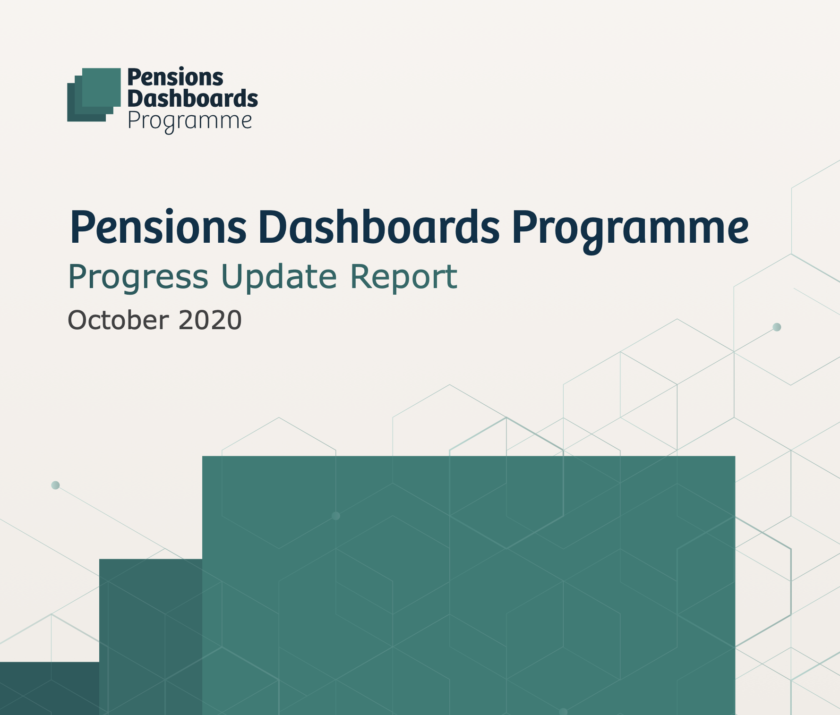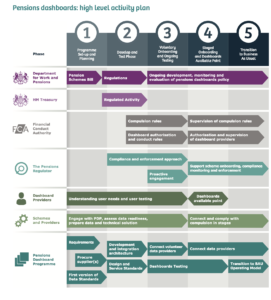The Money and Pensions Service’s (MaPS) latest progress report has set out an updated pathway for development of the programme, starting with procurement for the digital architecture, but has drawn industry criticism for the 2023 timeline for a consumer-ready dashboard.
Pensions Dashboards will enable individuals to access their pensions information online, securely and all in one place, thereby supporting better planning for retirement and growing financial wellbeing.
The Pensions Dashboards Programme (PDP) was set up by MaPS in July 2019 – with Chris Curry as principal – taking responsibility for establishing the ecosystem for the dashboards and developing the secure digital architecture and governance framework to make pensions dashboards operational.
The latest document sets out five phases (see table below), from set up and planning though to working dashboards, with each phase subject, Curry said, to “many dependencies”.
Anthony Rafferty, managing director of Origo, one of the FinTech’s involved in developing the prototype of the Pensions Dashboards, said with the PDP now focussed on scaling up the programme, the key practical elements scheduled over the next six months, including procurement of the digital architecture, identity verification, publication of data standards, and development of an onboarding strategy, “will move the project forward”.
Rafferty said: “We are pleased to see that digital architecture procurement is the next step being taken, with the process starting by the end of this year.
“The digital architecture is the cornerstone of the dashboard as it is crucial to integration for participants, for testing and to support the provider onboarding exercise. It allows also for other key areas which go hand-in-hand with it, such as digital identity and data standards, to move forward.”
He added: “The pensions industry and FinTechs have made great strides over the past few years in developing and progressing the architecture and services needed to build the dashboards. Proof of concept and working prototypes integrating the key technologies and showing how digital identity verification, delegated access and data enrichment may be integrated, have already been delivered, which hopefully can feed into the next stage of the MaPS pathway, accelerating this stage of the process to help make dashboards accessible to individuals as soon as possible.
“Origo has continued to work closely with our development partners since the original prototype project right through to now and stands ready with well formulated technology and service models to support rapid progress.”
Kate Smith, head of Pensions at Aegon, said it was “good news” that the first set of data standards was scheduled to be published in December allowing all pension schemes and providers time to get their data in order for launch of consumer-ready dashboards. But she added, there is “a great deal of work to be done… not only for the Pensions Dashboard Programme, but also for all pension providers and schemes, FinTech, the government and regulators.”
“So far,” she added, “there has been incredible engagement from all stakeholders showing a genuine willingness to push Pension Dashboards forward and improve people’s financial wellbeing by providing an informed and complete picture of their retirement savings.”
Criticism
However, a factor considered key to the success of the dashboards, the compulsion for pension schemes to connect and deliver data, will not occur until Stage 4, the ‘dashboards available point’. Only at this point will there be a sufficient number of pensions available via the dashboard to be of use to a critical mass of consumers.
This stage is timetabled in the report as ‘from 2023’, which has drawn criticism from industry commentators, who have highlighted the four-year delay this represents on the original target of 2019 (as set out in the 2016 Budget).
Royal London pension specialist Helen Morrissey commented: “After already progressing at a snail’s pace for some time it is hugely disappointing to see this project further delayed. Of course such projects are complex but the potential that dashboards have to help people take control of their retirement planning is huge and must be grasped. Every delay risks letting down a generation of savers.”
Jon Greer, head of retirement policy at Quilter, concurred that the 2023 launch “will come as a disappointment to many” adding that it was “very important that people keep track of their various pensions and where appropriate consolidate”.
However, Tom Selby, senior analyst at AJ Bell, considered a measured approach to dashboards introduction, “allow breathing space for proper consumer testing to determine the best ways to engage savers with information about their retirement pots” as sensible. He said: “Rushing the introduction of half-baked pensions dashboards would have risked causing terminal damage to a project which has the potential to revolutionise retirement engagement in the UK.”
Aegon’s Smith added: “Implementing pension dashboards is proving to be an extremely complex but worthwhile challenge.” She said it was “disappointing” that the timetable had been pushed out by four years, but added “we believe the delay is worthwhile using the extra time to get things right.
“Critical mass is needed from day one, to allow people to find the majority of their pensions. Compulsion will be staged, and it’s important that given the extra time, the staging process is short to gain critical mass quickly and that this is continually monitored. Without this it runs the real risk that people will be put off using pension dashboards.”
Next six months
The PDP’s latest update identified 9 key activities the PDP will pursue over the next six months, including:
- procuring a supplier(s) to deliver the dashboards’ digital architecture
- finalising requirements for identity verification
- publishing of data standards (December 2020)
- developing an onboarding strategy for pension providers and schemes
- identifying the first set of volunteer pension providers, schemes and administrators to help develop and test the digital architecture; and
- developing policy thinking around liability and consumer protection.




































